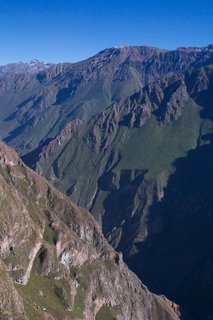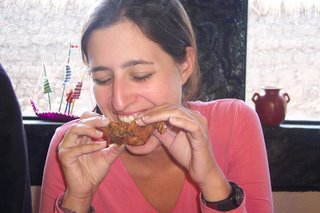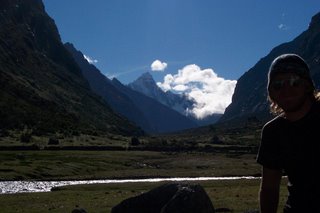
Budget Bolivia
 Bolivia - An exciting place
Bolivia - An exciting place
When I first arrived in South America, I had no intentions of seeing Bolivia due to my carefully formulated and foolproof plan to simply knock on the door and gain employment with my company GHD in Chile. Over the course of my time during Peru however I had been picking up distinctly non-good vibrations, and certainly no excitations from the Santiago office and with seemingly less onorous demands on my time of arrival in Chile as a result of that diminishing likelihood, Bolivia came distinctly within the radar for a number of reasons. Obviously I was keen to check out this relatively unknown country of high plateaus, Andean mountains, Amazonian jungle and blinding salt flats but I was also fortunate enough to have the chance to travel with yet more Dutch friends of mine who had coinciding plans. Of course the fact that it was dirt cheap added to its appeal. That and the cocaine...
.

.
One last day of shopping for gringo goodies with my beuna amiga, Devin, one of several folk whom made my time in Cusco so enjoyable.
.
It was hardly as if I'd been living an exorbitant existence in Cusco, a thoroughly affordable place in it's own right, but tales abounded from many a traveller of just how much bang your buck could achieve in Bolivia. High adventure for low cost was the general gist of it and so, following a few days completing a few essential Cusco experiences (I finally bought a damn finger puppet...) and saying goodbye to all the great folk I had met there, I headed south towards the Bolivian border.
.
.
Puno, the Monte Carlo of the Andes, only with much shittier boats.
.
Of course there was one more stop to make before leaving Peru indefinitely; one can hardly ignore the essential experience of Lake Titicaca, which at 3800m is the world's highest navigable lake and straddles the border between Peru and Bolivia. Its a pretty important place supposedly as Indian legend says the sun god had his children, Manco Capac and his sister Mama Ocilo, spring from the frigid waters of the lake to found Cuzco and the beginning of the Inca dynasty. The majority of the lake actually falls in Bolivian territory but the Peruvian town of Puno is considered the best site from which to embark on a tour of the Lake's islands, both those formed by natural and man-made processes.
.
.
Several of the some 40-odd floating islands near Puno.
.
There are a number of floating islands made up of the reeds that grow abundantly in the lake's shallows which have been habituated and continually replenished with fresh top layers of reeds by the Uros people who initially settled on them to escape those land-lubbering and war-mongering Incas some 500 years ago. These islands in particular are the main attraction of the countless tours of the lake that as always are shoved in your face immediately upon disembarking your bus.
.
.
Close up of the islands - like walking on a big spongy mattress and below, a touch of home. Not only did I spot the Aussie flag in one of the few residences on the island, there was also a huge number of eucalyptus gum trees, supposedly imported from Oz for their erosion prevention qualities and the islander's thriving trade in koala skins.
.

Tis certainly amazing how dexterous the folk who continue to reside permanently on the islands are with their reeds. They eat them, drink them, live under them (all their shelters are constructed from the reeds), sleep on them, and of course they use them to make useless trinkets that tourists lap up by the dozen. Another blatant tourist trap those crafty islanders employ are trips in their admittedly impressive reed boats, reminiscent of old Viking ships. I unfortunately fell for this one expecting to cross over to one of the main islands and forked out 5 sol (ok, it was only like $2) which is still quite a lot to sit in a boat over what eventuated to be a distance that Thorpie could cover in about 24 seconds.
.
Alas the ride to the main island on the agenda, Isla Taquille, was undertaken in the far less exotic diesel engined tour boat which was only marginally more hasty than the long-pole powered reed boats. After some 90 minutes of puttering across the open expanse of water (early suspicions that the lake was in fact quite large, proved correct), we finally arrived at Isla Taquille supposedly for a true Titicaca experience. Seemingly this simply involves hanging out with a whole bunch of gringos in the town square for an hour whilst the locals try to flog you stuff that isn't even half as impressive as the little reed keyrings on the other island. Alas this memorable encounter had to end, and so it was then another 3 hour journey spluttering back to the mainland.
.
Scenes from Cocacabana town, our first stop in Bolivia. Another example of whacked or spot-on priorities depending on your point of view.
.
.
The next morning I was met by one of my many Dutch friends, Charlotte, and the two of us headed to the border where I left Peru with the distinct hope of returning some day. We didn't move much beyond the border as we chose to stay at another Lake town, the infinitely prettier Cocacabana (the highest port south of Havana...). Our first impression of Bolivia was certainly a positive one, a fabulous trout meal (a Titicaca specialty), sunny weather, and a beautiful hotel with stunning views of the lake (and hot showers with PRESSURE!!) for around $6 each. A highlight was the hike up the neighbouring mountain which provided views over the town and a spectacular vantage point for watching the sunset over the lake which stretched beyond the horizon.
.
Cheap wine and a three month growth. Enjoying the sunset over Titicaca.
.
.
Alas our Coca experience proved to be a blip on the radar so far as quality is concerned for it seems the deeper you head into Bolivia, the drop in standards more than keeps pace with the dropping prices. Our rickety bus to La Paz was a case in point and proved two things; the lake is even bigger than I had imagined, and the buses in Bolivia are entirely shithouse. At least the same cannot be said of the vista one experiences when first driving into La Paz, the highest capital city in the world and surely also one of the most spectacularly located. Basically a huge depression surrounded by a ring of Andean peaks with the city sprawling up the slopes seemingly until they become too steep to support any more dwellings.
.
The spectacular setting of La Paz.
.
.
(Below left) Maybe they're taking things a bit far when they start counterfeiting cars as this "Toyosa" suggests. The bowling ball shaped woman aptly sporting a bowler hat is also a very common sight in Bolivia.
.

We checked into the first of several dive hotels in central La Paz (again super cheap - we had a room for four people to ourselves for around $10 - of course only two could safely support the weight of a human body) and headed out to start making the most of the cheap luxuries on offer, namely the restaurants with meals for which we paid only between $3 and $4. Certainly not fine dining by any standards but thoroughly edible and undeniably good value for the cost.
.
(Below) Myself, Joram and Charlotte eating out again at the markets in La Paz.
.

Or so I thought. As a further example of my inability to escape the company of those from the Nether regions, I met up with two good mates from Cusco, Joppe and Joram, who took the stereotype of the "tight Dutchman" to an altogether new level. They swore by eating only at the giant markets in the centre of town where you could buy a tasty chicken and rice meal for 60c, or a choripan for half that. I was quickly convinced of their logic and was soon eating there at every opportunity as well. My favourite were the incredible amount of fruit stalls served by the typically rotund fruit ladies who could whip up a monstrous fruit salad totally from fresh produce of your choice again for less than a dollar. A litre of fruit juice made to your specifications set you back a ridiculous 2 bolivianos.
.
Considering there are more than 6 Bolivianos to one Aussie dollar, 2 Bolivianos is hardly a noteworthy sum but it of course still represents a not inconsequential amount to locals. There seems to a spate of counterfeiting currency in Bolivia at present and one ultra-suspicious gentleman refused to accept a slightly tarnished 2 Boliviano coin I presented as payment. My seemingly logic arguments of the futility of counterfeiting such an inconsequential sum fell on deaf ears and I was forced to find an alternative note to pay for my internet.
.
My beloved fruit ladies...
.
All that eating at local markets complete with their non-existent practices of hygiene did of course catch up with me when a 25c hotdog played havoc with my bowels preventing me from heading out on the popular Choro trek just outside of La Paz. The disappointment of that missed opportunity was softened by the knowledge that we experienced more or less the same environment whilst completing arguably one of the most enjoyable experiences I've had on my entire trip.
.
The money shot of the bike ride down the "World's Most Dangerous" road.
.
I write of the WMD, or World's Most Dangerous road where the only weapons of mass destruction to be found were the madcap Bolivian trucks hurtling down the 65km stretch towards Brazil. It's a lot safer than it sounds, it merely has the title because it was officially listed by the WHO or some other international organisation of repute as being the road with the most fatalities in a particular year. Of course it also lures a lot of tourists to buy a T-shirt of the "I did it" ilk. I also picked one of these up (it was included in the cost!!) and it is amazing how many people you run into all over the continent all sporting similar apparel.
.
Obviously it is not the safest road but I get the feeling that most of those fatalities were the result of coked-up Bolivian truck drivers trying to deliver their "merchandise" across the border as quickly as possible, a risky proposition on a single lane, two-way dirt road winding down some 3.5 vertical kilometres on the sides of mountains. All in all it makes for one hell of bike-ride.
.
A shot of whiskey/straight metho to toast to our hopefully good health before commencing. Thankfully nobody rode off the edge that day.
.
Apart from a brief stretch of up-hill riding (ridiculously exhausting at some 4000m) it's pretty much just a point your wheels down and hold on tight situation. The first 25km or so are on pavement where you actually dodge in and out of the slower moving traffic but the real fun begins when you hit the 40km+ of dusty gravel road with the side of a mountain on your right, and a several hundred metre vertical drop on your left for much of the time. Being the vehicle descending, the rules of the road are of course that you need to remain on the left. Being that it is barely wide enough to support one vehicle width, it is a slightly nerve-wracking experience when passing an oncoming vehicle....
Some of the unnecessarily distracting scenery encountered on the way down. Below is me watching the second guy make it up the tough up-hill section. That's right, estoy numero uno...
.
.
The amount of commemorative crosses you pass on the way down is enough to keep your wits about you but I have rarely had more fun than when just going flat out down that hill, sliding round corners and letting go of the brakes, all the while trying not to be distracted by the incredible scenery all around me. I seriously recommend anyone passing through Bolivia to make it one of your priorities. An exhausting, dusty, exhilarating and entirely satisfying experience I will remember for a long time.
.
A very dusty but satisfied crowd at the end of the ride. Next was the dangerous part; driving back up the road...
.
.
(Below) Me and Charlotte at the ridiculously schmick dessert restaurant in La Paz complete with classy faux waterfalls.
.

Following this we had a few more days in around La Paz where we were eventually joined by our other Dutch friend Danielle, and spent our time in a variety of pursuits such as a hiking a beautiful local day trek, exploring the bizarre Valle de la Luna (valley of the moon), having our shoes cleaned by the terrorist-looking shoe shiners (they all wear balaclavas supposedly to avoid being recognised and thus avoid bringing "shame" on their family due to their lowly-esteemed profession), and also eating copious amounts of the best icecream I've ever had for a fifth of the price that you would pay at Cold Rock.
.
.
Some views from the day hike I did with Charlotte, Joram and Joppe. You can see the first stretch of the bike ride winding down in the the background. Below is the view out towards Brazil and the beginning of the Amazon rainforest. I think.
.
.
The other activity that preoccupied much of my time in La Paz was shopping for the ridiculous amounts of Alpaca wool clothes that I made the mistake of offering to buy for my family. Once this two day mission (which they better be especially grateful for) was over, I left myself a good two hours to simply put all 11kg of the stuff in a box and post it back to Australia before with immaculate timing, jumping on a night bus heading for Uyuni. Like my Mumbai experience, this was to prove frightfully insufficient.
.
Another shot from our lookout point of the WMD road.
.
.
Who'd want to be an electrician in La Paz? Typical of the chaotic disorganised feel of the city, these wire criss-crossed all over the city and often were directly under roof water discharges. Crazy.
.
For starters, the amount of money I had planned for posting turned out to be horribly short due to the fact that the information lady, upon confirming my quoted price from my previous questioning, had never in fact even heard of Australia. Austria sure, but Australia was evidently one of those mysterious countries in the "rest of the world" category which happen to be double the price. Setback number two was that the box lady was adamant that the cost of postage would be the same whether I put my cargo in one large box as in two smaller ones. I was sceptical but assumed that, being that it was her profession, she may have some idea what she was talking about.
.
Taking the concept of the zebra crossing to the next level. Supposedly these crazy dancing zebras are necessary to ensure the drivers stop at the lights. That or it's a novel way of reducing unemployment.
.
Umm, no. After filling in all the forms with a detailed description of all the items and wrapping up the boxes up securely and addressing them ready for postage I was informed that I would be of course required to pay the postage for two 6kg packages rather than one large 11kg package. Apart from being some $50 or so more expensive, it was also highly time consuming and damaging to my best laid plans of catching an imminently departing bus. Once again I failed the patience and calmness test in dismal fashion. Despite my pidgeon spanglish rants of "not my fault, not my fault. Your fault. Me no pay more!!" I was eventually forced to fork out the cash and sprint back to my hotel which quickly turned into a forlorn power walk considering the difficulty of physical exertion at that altitude...
.
Main governing square of La Paz.
.
Of course despite my panic, turns out I had nothing to worry about as I had yet again overestimated the quality of service availabe in these countries. The Bolivian time lag constant was in my favour on this occasion and despite turning up 20 minutes late to the bus station, where I found that my bus in fact was leaving from the train station (of course, how stupid of me...) and hence was forty minutes late, I still had to wait for another half hour before we headed off. And this was the only bus for that entire day that ran arguably the most popular tourist route from La Paz to Uyuni, the launching pad for tours of the famous salt plains.
.
More tastes of home, the green and gold of the Aussie wattle plant with some gum trees in the background. Both are pretty common around La Paz.
.

They should really issue public health warnings to all those considering travelling by bus in that part of the world. Firstly the engine was exposed in the driver's cabin and one was required to step over the gaping hole when boarding and for the rest of the night an unfortunate Brit had to keep the door closed with his leg to prevent the fumes billowing through to the rest of us. Much worse was the fact that despite wearing a three layers, not to mention a down jacket and complimentary blanket, and taking TWO valiums, I couldn't get an ounce of sleep primarily due to the deafening chatter of teeth and knocking of knees. I'm talking serious arctic conditions, the windows were completely iced over and I had no feeling in my face, hands and feet for most of what was a very ordinary journey.
.
The reason why people go to Uyuni, the trippy landscapes of the salt plains.
.
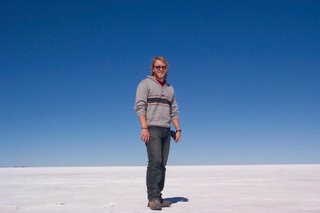
After enduring such a painful trip it was entirely disheartening to disembark in what must be one of the most unwelcoming, desolate places on the continent. Understandably at 7am on a freezing morning (well below zero), the place gave the impression of a deserted ghost town; one almost expected some tumbleweed to blow down the dusty streets but I dare say the place was too arid for any vegetation to grow at all. And in truth, it wasn't entirely deserted, we were of course met by an armada of tour operators all plying their trade of flogging the only reason why anyone would want to pass through such a place.
.
A Toyota, or possibly a Toyosa, speeding across the seemingly endless expanse of the Salar de Uyuni.
.
Thus loaded up with 12 flyers that I was too debilitated to resist, I hobbled away on my numb stumps for legs to another dingy Bolivian hotel wondering how I was going to fill up a whole day in this place before being joined by my Dutch girls the next day. After lying comatose under 6 blankets for several hours, I spent the rest of the day sifting through the dozens of tour operators (I think there are more than 50 companies in a town of only a few thousand people) and ultimately flipped a coin to break the deadlock between the companies offering the best deals. This more or less required about 50 coin tosses as there is little discernible difference between any of them and its pretty much luck of the draw as to whether you get a pimped up beast-from-the-east (i.e. a landcruiser) or a clapped-up pickup truck running on it's third engine.
.
Charlotte and I atop some of the memorable rock sculptures encountered during our 3-day salt plains tour.
.
A quick aside, I mentioned that the giant pimple that is Uyuni only exists on the tourist radar for its proximity to the salt planes, but there is one other redeeming feature which almost makes Uyuni a worthwhile destination in it's own right. MinuteMan Pizza. A super restaurant run by an American expat with his Bolivian wife which makes the best pizza I've had in my life. Period. Had I stayed any longer in Uyuni I may have considered setting up camp on the street outside.
.
Anyways, with a tour booked and stomach still in shock from the previous night's feast, I met the girls early the next morning, by the state of them they had also neglected to bring their fur-lined down suits on board the arctic express from La Paz. Unfortunately for them they pretty much had to jump straight into our cramped 4WD (there were two more Dutchies in our group, they're a virus I swear) and head out to the flats. We at least had time to squeeze in a quick breakfast as MinuteMan's. They also make arguably the best pancakes....
.
.
Aww, he's so cute. I'm referring to the llama if there's any confusion. Which there is not...
.
From Uyuni, it was pretty much straight out to the surreal and blindingly white expanses of the Salar de Uyuni, via a quick stop at the unique Cemeterio del Locomotivos and several tourist trinket traps. I did at least fulfill one of my main South American ambitions in that I got to hold a llama.
.
Me at the helm of one of the many locomotive corpses scattered about the Cemeterio de Locomotivos.
.
.
The interior of the salt hotel, constructed inside and out, furniture and all, of yep, you guessed it, salt.
.

The Salar de Uyuni is huge and you essentially spend half a day driving across its seemingly endless plains all the while attempting to set new land speed records for 1990 model Toyota (and Toyosa one suspects) landcruisers. Two noteworthy stops are however the impressive and aptly named Salt hotel, and the distinctly inappropriately named Isla Pescado (Island of fish). Where the hell any fish were in one of the driest places on earth I have no idea, I personally think the title of Isla de Fálico Cactos would have been more suitable.
.
.
Me standing on the mysteriously titled Isla Pescado with the many cacti which cover the island in the background. I guess there may have been fish about there at some stage for below is some fossilized coral which was somehow under water a long long time ago.
.
.
The next few days followed a similar theme of surreal out-of-this-world landscapes interspersed with long periods of mind-numbing driving followed by freezing nights in dive hotels in the middle of nowhere. The highlights package was worth it however and you tend to forget the hours of pent-up tedium when reflecting upon the many impressive landscapes we encountered.
.
Me, Danielle and Charlotte above Laguna Colorado and below is the aptly if not overly imaginatively named Laguna Verde, or Green Lake with a big volcano in the background which I cannot remember the name of.
.
Of particular note were the numorous coloured lakes, Lagunas Colorado and Verde in particular, and the Desierto de Salvador Dalí, the scene of (many of?) his most famous paintings, with its incredible naturally sculpted rock features including the immediately recognisable rock tree.
.
.
I tried to recreate the scene of Dali´s famous melting clocks with my watch but it just didn't quite fit the scale....
.
.
People went bananas about the flamingoes as well but I shall again be one of those irritating traveller types and express my distinct lack of enthusiasm for this "highlight" of the tour. When you have seen several million of the things lining a lake in Kenya, you are hardly quick draw McGraw with the camera upon the distant sighting of anything pink.
.
Alas the end of the tour for me also signalled the end of my oh-so-brief jaunt through Bolivia and also this oh-too-bloated blog entry. One last and typically freezing night in Bolivia was followed by pre-dawn excursion to the geysers, which I enjoyed for all of the 15 seconds I could bare to be out of the car, and then the infinitely more pleasurable and sirenesque hot springs which they almost had to winch me out of. It was then to the drop off point where a bus was waiting to make the short trip over the nearby Chilean border.
.
.
Me and an entirely fake geyser. There were real ones however.
.
It was certainly said to say goodbye to Charlotte and Danielle, the last of my many good Dutch friends from Cusco but it was just as sad to say goodbye to the Boliviano and all it entailed. Gone for good were those 30c juices and $4 hotel rooms; I was in for some serious culture shock in Chile. But at last the time had come to get to Santiago and achieve my main ambition and inspiration for this entire trip. Time to get a job....
.
Goodbye Bolivia...
.






 Tis certainly amazing how dexterous the folk who continue to reside permanently on the islands are with their reeds. They eat them, drink them, live under them (all their shelters are constructed from the reeds), sleep on them, and of course they use them to make useless trinkets that tourists lap up by the dozen. Another blatant tourist trap those crafty islanders employ are trips in their admittedly impressive reed boats, reminiscent of old Viking ships. I unfortunately fell for this one expecting to cross over to one of the main islands and forked out 5 sol (ok, it was only like $2) which is still quite a lot to sit in a boat over what eventuated to be a distance that Thorpie could cover in about 24 seconds.
Tis certainly amazing how dexterous the folk who continue to reside permanently on the islands are with their reeds. They eat them, drink them, live under them (all their shelters are constructed from the reeds), sleep on them, and of course they use them to make useless trinkets that tourists lap up by the dozen. Another blatant tourist trap those crafty islanders employ are trips in their admittedly impressive reed boats, reminiscent of old Viking ships. I unfortunately fell for this one expecting to cross over to one of the main islands and forked out 5 sol (ok, it was only like $2) which is still quite a lot to sit in a boat over what eventuated to be a distance that Thorpie could cover in about 24 seconds. 





 We checked into the first of several dive hotels in central La Paz (again super cheap - we had a room for four people to ourselves for around $10 - of course only two could safely support the weight of a human body) and headed out to start making the most of the cheap luxuries on offer, namely the restaurants with meals for which we paid only between $3 and $4. Certainly not fine dining by any standards but thoroughly edible and undeniably good value for the cost.
We checked into the first of several dive hotels in central La Paz (again super cheap - we had a room for four people to ourselves for around $10 - of course only two could safely support the weight of a human body) and headed out to start making the most of the cheap luxuries on offer, namely the restaurants with meals for which we paid only between $3 and $4. Certainly not fine dining by any standards but thoroughly edible and undeniably good value for the cost. Or so I thought. As a further example of my inability to escape the company of those from the Nether regions, I met up with two good mates from Cusco, Joppe and Joram, who took the stereotype of the "tight Dutchman" to an altogether new level. They swore by eating only at the giant markets in the centre of town where you could buy a tasty chicken and rice meal for 60c, or a choripan for half that. I was quickly convinced of their logic and was soon eating there at every opportunity as well. My favourite were the incredible amount of fruit stalls served by the typically rotund fruit ladies who could whip up a monstrous fruit salad totally from fresh produce of your choice again for less than a dollar. A litre of fruit juice made to your specifications set you back a ridiculous 2 bolivianos.
Or so I thought. As a further example of my inability to escape the company of those from the Nether regions, I met up with two good mates from Cusco, Joppe and Joram, who took the stereotype of the "tight Dutchman" to an altogether new level. They swore by eating only at the giant markets in the centre of town where you could buy a tasty chicken and rice meal for 60c, or a choripan for half that. I was quickly convinced of their logic and was soon eating there at every opportunity as well. My favourite were the incredible amount of fruit stalls served by the typically rotund fruit ladies who could whip up a monstrous fruit salad totally from fresh produce of your choice again for less than a dollar. A litre of fruit juice made to your specifications set you back a ridiculous 2 bolivianos. 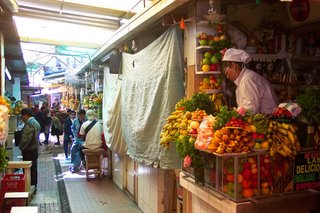







 Following this we had a few more days in around La Paz where we were eventually joined by our other Dutch friend Danielle, and spent our time in a variety of pursuits such as a hiking a beautiful local day trek, exploring the bizarre Valle de la Luna (valley of the moon), having our shoes cleaned by the terrorist-looking shoe shiners (they all wear balaclavas supposedly to avoid being recognised and thus avoid bringing "shame" on their family due to their lowly-esteemed profession), and also eating copious amounts of the best icecream I've ever had for a fifth of the price that you would pay at Cold Rock.
Following this we had a few more days in around La Paz where we were eventually joined by our other Dutch friend Danielle, and spent our time in a variety of pursuits such as a hiking a beautiful local day trek, exploring the bizarre Valle de la Luna (valley of the moon), having our shoes cleaned by the terrorist-looking shoe shiners (they all wear balaclavas supposedly to avoid being recognised and thus avoid bringing "shame" on their family due to their lowly-esteemed profession), and also eating copious amounts of the best icecream I've ever had for a fifth of the price that you would pay at Cold Rock.




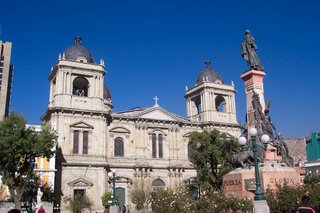
 They should really issue public health warnings to all those considering travelling by bus in that part of the world. Firstly the engine was exposed in the driver's cabin and one was required to step over the gaping hole when boarding and for the rest of the night an unfortunate Brit had to keep the door closed with his leg to prevent the fumes billowing through to the rest of us. Much worse was the fact that despite wearing a three layers, not to mention a down jacket and complimentary blanket, and taking TWO valiums, I couldn't get an ounce of sleep primarily due to the deafening chatter of teeth and knocking of knees. I'm talking serious arctic conditions, the windows were completely iced over and I had no feeling in my face, hands and feet for most of what was a very ordinary journey.
They should really issue public health warnings to all those considering travelling by bus in that part of the world. Firstly the engine was exposed in the driver's cabin and one was required to step over the gaping hole when boarding and for the rest of the night an unfortunate Brit had to keep the door closed with his leg to prevent the fumes billowing through to the rest of us. Much worse was the fact that despite wearing a three layers, not to mention a down jacket and complimentary blanket, and taking TWO valiums, I couldn't get an ounce of sleep primarily due to the deafening chatter of teeth and knocking of knees. I'm talking serious arctic conditions, the windows were completely iced over and I had no feeling in my face, hands and feet for most of what was a very ordinary journey.





 The Salar de Uyuni is huge and you essentially spend half a day driving across its seemingly endless plains all the while attempting to set new land speed records for 1990 model Toyota (and Toyosa one suspects) landcruisers. Two noteworthy stops are however the impressive and aptly named Salt hotel, and the distinctly inappropriately named Isla Pescado (Island of fish). Where the hell any fish were in one of the driest places on earth I have no idea, I personally think the title of Isla de Fálico Cactos would have been more suitable.
The Salar de Uyuni is huge and you essentially spend half a day driving across its seemingly endless plains all the while attempting to set new land speed records for 1990 model Toyota (and Toyosa one suspects) landcruisers. Two noteworthy stops are however the impressive and aptly named Salt hotel, and the distinctly inappropriately named Isla Pescado (Island of fish). Where the hell any fish were in one of the driest places on earth I have no idea, I personally think the title of Isla de Fálico Cactos would have been more suitable. 









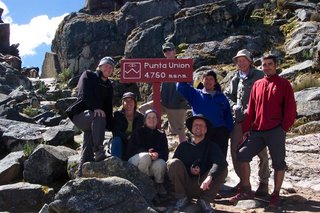
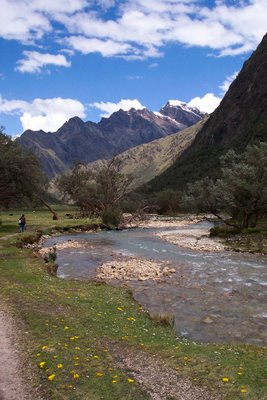
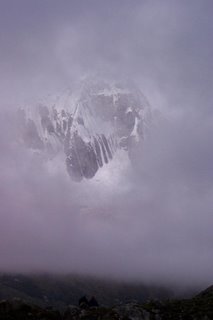
 More scenes from the Santa Cruz trek.
More scenes from the Santa Cruz trek.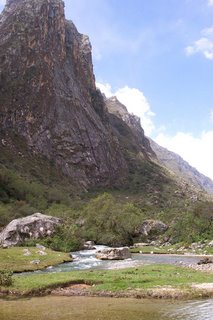


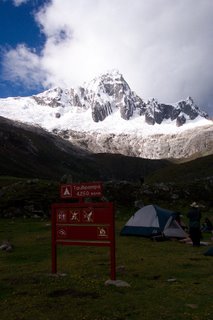

 Above is a side trip we did to the glacial lake and below is the valley through whence we came.
Above is a side trip we did to the glacial lake and below is the valley through whence we came.
 (Above) The Paramount mountain? It kind of looks like it, would help if the stars were there.
(Above) The Paramount mountain? It kind of looks like it, would help if the stars were there.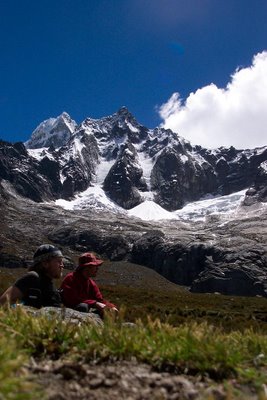
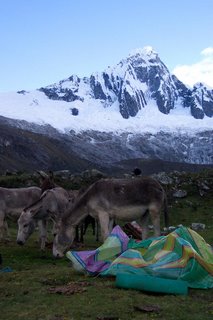
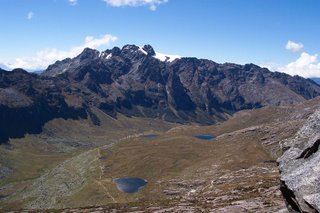
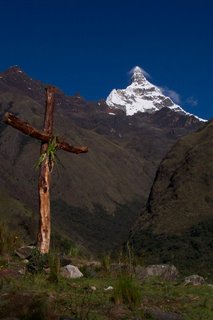
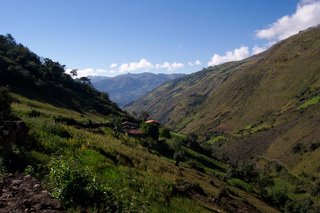

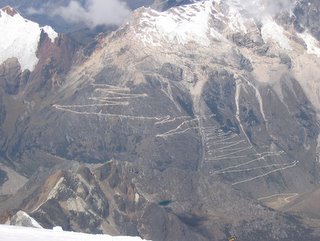

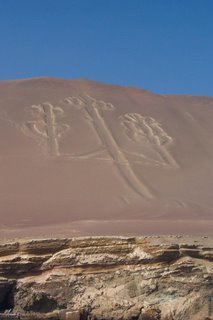
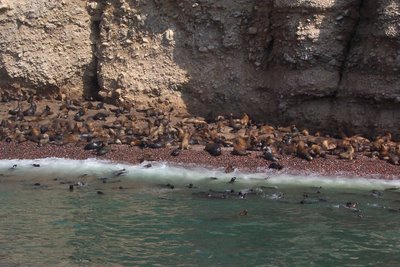

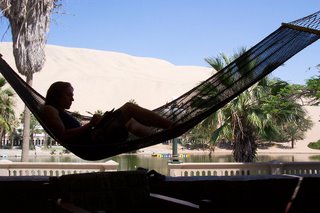
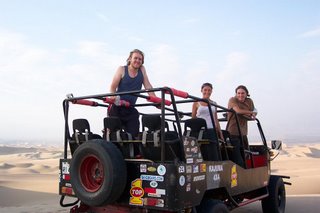

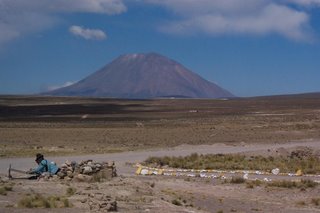 The volcano El Misti that dwarves the city of Arequipa on the other side.
The volcano El Misti that dwarves the city of Arequipa on the other side.
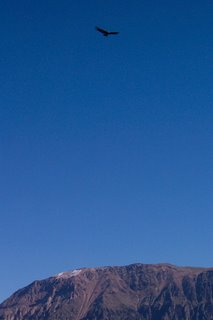 Above was about as close as I got to a Condor. Still, it was spectacular scenery.
Above was about as close as I got to a Condor. Still, it was spectacular scenery.